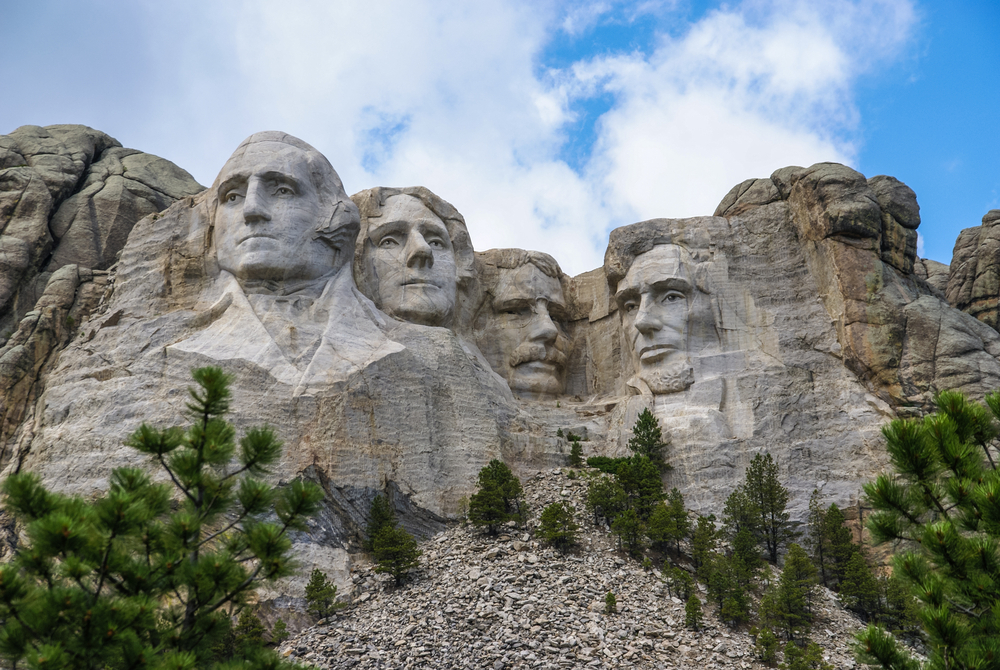
To many Americans, Mount Rushmore is a significant landmark honoring four of the nation’s presidents. To Indigenous people, it’s yet another physical example of the racism and hostility they’ve experienced over the last few centuries. President Trump’s visit to Mount Rushmore in July of 2020 called new attention to already existing tensions over the monument. To understand why many Indigenous Americans are so angry about the landmark, it’s important to know the history behind its creation and the land upon which it sits.
Sacred Lands and Their Significance
The Black Hills, known as “Ȟe Sápa” to the Lakota, cover parts of western South Dakota and Wyoming. Writing for Cultural Survival, Leonard Little Finger mentions that the region is sacred to the Lakota and other groups part of the Seven Council Fires–a confederation of Great Plains civilizations that also encompass Dakota and Nakota cultures. He likens the mountains’ deep dark colors to dried buffalo hide containers. Just as they carried sacred pipes, food, and items used in prayers, he says, the Black Hills are a spiritual container for his people.
Located in the Black Hills of South Dakota, Mount Rushmore was originally named “Tȟuŋkášila Šákpe” by Lakota medicine man Nicholas Black Elk. The Native Hope blog explains that Black Elk had a vision about six sacred directions– west, east, north, south, above, and below–and saw them representing “kindness and love, full of years and wisdom, like human grandfathers.”
The Black Hills as Stolen Land
If the Black Hills were originally Indigenous lands, how did they become American property? As American settlers moved westward, they encountered Native people already on these lands. Conflicts between the two ensued. As the National Archives explain, the Sioux Treaty of 1868 was an attempt to broker peace. Signed at Fort Laramie, the treaty stated that the Black Hills were part of Sioux territory and could only be occupied by the Sioux peoples.
However, the US government would soon renege on the agreement. Triggered by rumors of gold in the region, General George A. Custer led an expedition and laid claim to the Black Hills in 1874. Miners and prospectors followed, along with a railroad built and funded by the government. This violated the 1868 treaty, and conflict was inevitable. The result was the Battle of the Greasy Grass, but you probably know it best as the Battle of the Little Bighorn.
Custer suffered an astounding defeat at the hands of the Sioux, but the US government swiftly retaliated with a “Sell or Starve” law enacted by Congress. Cutting off all rations to Sioux Territory, the government effectively forced the Sioux off their lands. By 1877, it had claimed possession of the Black Hills.
The Story Behind Mount Rushmore
PBS’s series “The American Experience” explored the history of Mount Rushmore’s creation. In the 1920s, South Dakota historian Doane Robinson had an idea to create a monument honoring “great heroes of the West.” Robinson’s vision originally included both Natives and settlers, but the man he hired to craft the landmark had different ideas. Sculptor Gutzon Borglum convinced Robinson that honoring presidents would give the work “national significance.” As PBS puts it, the resulting monument was a three-fold insult to the Sioux peoples: constructed on stolen land, desecrating sacred grounds, and celebrating people who harmed and killed Natives. Smithsonian Magazine’s revelation that Gorblum had ties to the Ku Klux Klan turns the landmark into a four-fold insult.
What’s Next for Mount Rushmore
Some, including Native leaders and even one of Gorblum’s descendants, call for Mount Rushmore’s removal. Others believe it can serve as an educational opportunity, with tourism proceeds redirected to Indigenous people. Meanwhile, we’re left to reckon with past injustices that the monument represents. Perhaps the time for that is long overdue.

